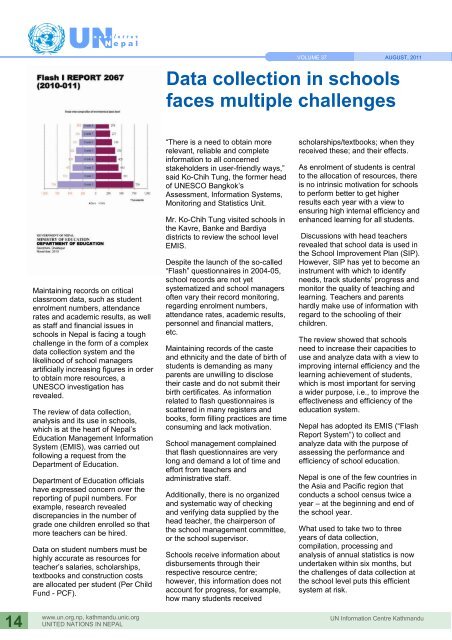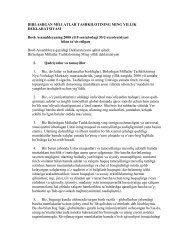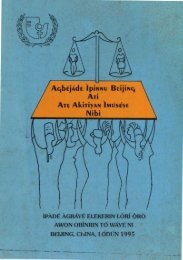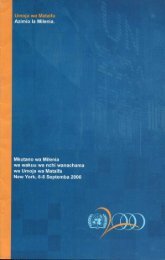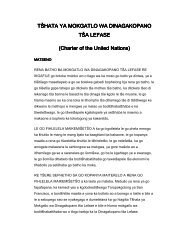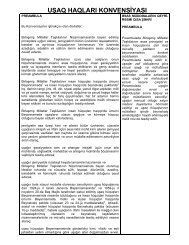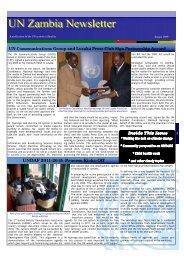Download Newsletter - United Nations Information Centres
Download Newsletter - United Nations Information Centres
Download Newsletter - United Nations Information Centres
Create successful ePaper yourself
Turn your PDF publications into a flip-book with our unique Google optimized e-Paper software.
14<br />
UN n e w s l e t t e r<br />
N e p a l<br />
Maintaining records on critical<br />
classroom data, such as student<br />
enrolment numbers, attendance<br />
rates and academic results, as well<br />
as staff and financial issues in<br />
schools in Nepal is facing a tough<br />
challenge in the form of a complex<br />
data collection system and the<br />
likelihood of school managers<br />
artificially increasing figures in order<br />
to obtain more resources, a<br />
UNESCO investigation has<br />
revealed.<br />
The review of data collection,<br />
analysis and its use in schools,<br />
which is at the heart of Nepal‘s<br />
Education Management <strong>Information</strong><br />
System (EMIS), was carried out<br />
following a request from the<br />
Department of Education.<br />
Department of Education officials<br />
have expressed concern over the<br />
reporting of pupil numbers. For<br />
example, research revealed<br />
discrepancies in the number of<br />
grade one children enrolled so that<br />
more teachers can be hired.<br />
Data on student numbers must be<br />
highly accurate as resources for<br />
teacher‘s salaries, scholarships,<br />
textbooks and construction costs<br />
are allocated per student (Per Child<br />
Fund - PCF).<br />
www.un.org.np, kathmandu.unic.org<br />
UNITED NATIONS IN NEPAL<br />
VOLUME 37 AUGUST, 2011<br />
Data collection in schools<br />
faces multiple challenges<br />
―There is a need to obtain more<br />
relevant, reliable and complete<br />
information to all concerned<br />
stakeholders in user-friendly ways,‖<br />
said Ko-Chih Tung, the former head<br />
of UNESCO Bangkok‘s<br />
Assessment, <strong>Information</strong> Systems,<br />
Monitoring and Statistics Unit.<br />
Mr. Ko-Chih Tung visited schools in<br />
the Kavre, Banke and Bardiya<br />
districts to review the school level<br />
EMIS.<br />
Despite the launch of the so-called<br />
―Flash‖ questionnaires in 2004-05,<br />
school records are not yet<br />
systematized and school managers<br />
often vary their record monitoring,<br />
regarding enrolment numbers,<br />
attendance rates, academic results,<br />
personnel and financial matters,<br />
etc.<br />
Maintaining records of the caste<br />
and ethnicity and the date of birth of<br />
students is demanding as many<br />
parents are unwilling to disclose<br />
their caste and do not submit their<br />
birth certificates. As information<br />
related to flash questionnaires is<br />
scattered in many registers and<br />
books, form filling practices are time<br />
consuming and lack motivation.<br />
School management complained<br />
that flash questionnaires are very<br />
long and demand a lot of time and<br />
effort from teachers and<br />
administrative staff.<br />
Additionally, there is no organized<br />
and systematic way of checking<br />
and verifying data supplied by the<br />
head teacher, the chairperson of<br />
the school management committee,<br />
or the school supervisor.<br />
Schools receive information about<br />
disbursements through their<br />
respective resource centre;<br />
however, this information does not<br />
account for progress, for example,<br />
how many students received<br />
scholarships/textbooks; when they<br />
received these; and their effects.<br />
As enrolment of students is central<br />
to the allocation of resources, there<br />
is no intrinsic motivation for schools<br />
to perform better to get higher<br />
results each year with a view to<br />
ensuring high internal efficiency and<br />
enhanced learning for all students.<br />
Discussions with head teachers<br />
revealed that school data is used in<br />
the School Improvement Plan (SIP).<br />
However, SIP has yet to become an<br />
instrument with which to identify<br />
needs, track students‘ progress and<br />
monitor the quality of teaching and<br />
learning. Teachers and parents<br />
hardly make use of information with<br />
regard to the schooling of their<br />
children.<br />
The review showed that schools<br />
need to increase their capacities to<br />
use and analyze data with a view to<br />
improving internal efficiency and the<br />
learning achievement of students,<br />
which is most important for serving<br />
a wider purpose, i.e., to improve the<br />
effectiveness and efficiency of the<br />
education system.<br />
Nepal has adopted its EMIS (―Flash<br />
Report System‖) to collect and<br />
analyze data with the purpose of<br />
assessing the performance and<br />
efficiency of school education.<br />
Nepal is one of the few countries in<br />
the Asia and Pacific region that<br />
conducts a school census twice a<br />
year – at the beginning and end of<br />
the school year.<br />
What used to take two to three<br />
years of data collection,<br />
compilation, processing and<br />
analysis of annual statistics is now<br />
undertaken within six months, but<br />
the challenges of data collection at<br />
the school level puts this efficient<br />
system at risk.<br />
UN <strong>Information</strong> Centre Kathmandu


